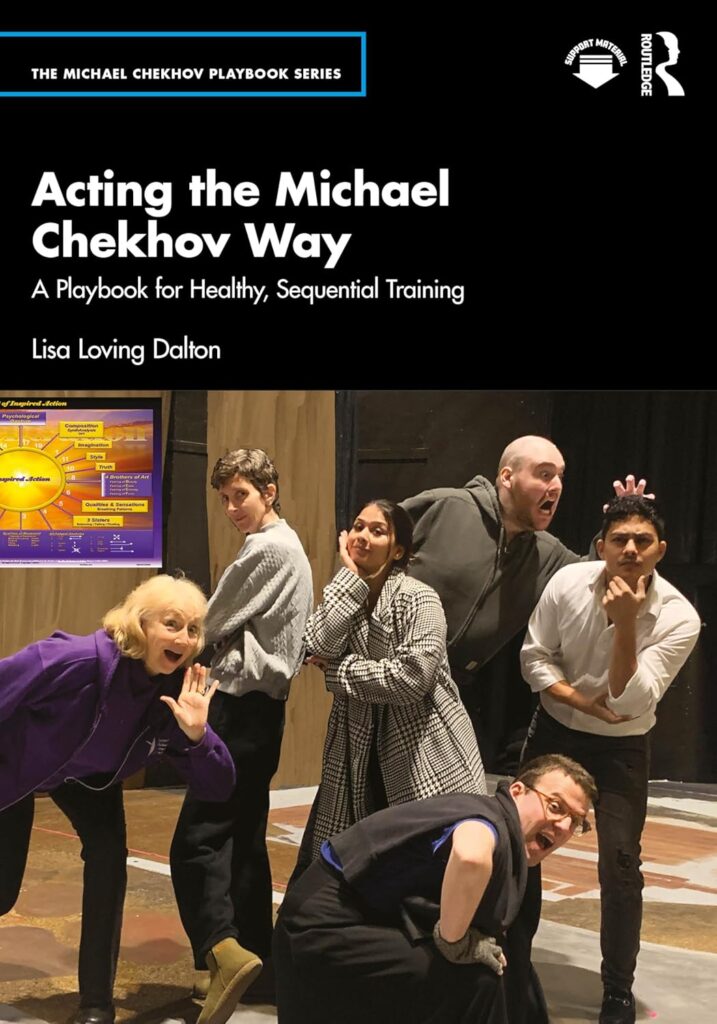
Rooted in Chekhov’s Guiding Principles and Laws of Composition, Acting the Michael Chekhov Way: A Playbook for Healthy, Sequential Training offers a step-by-step pathway for actors, directors, and teachers with an emphasis on the health and well-being of the performer.
Request Inspection Copy for Instructors
Developed over 30 years within the National Michael Chekhov Association’s renowned certification training, this clear, accessible training sequence for Michael Chekhov’s techniques is designed to support artists at every level.
The chapters build logically and functionally, layering in benefits for artistic and personal growth. Central to the approach is the Chart of Inspired Action, created by Chekhov for his student and estate executrix, Mala Powers, who co-founded this pedagogy with Dalton and Professor Wil Kilroy.
In these pages, Dalton introduces SynthAnalysis™, a groundbreaking synthesis of Stanislavsky’s analysis and Chekhov’s methods, bridging theory and practice tested through decades of global application.
She also shares anecdotal insights from her 45-year acting/stunt career and draws on Chekhov’s esoteric inspirations—elements often absent in most books and teachings on Chekhov. The book presents mystical concepts like the goblet in playful, functional ways, empowering artists to use them as imaginative metaphors and explore their deeper potential.
A helpful tool for both solo and classroom use, Acting the Michael Chekhov Way will speak directly to the actor and their teachers, guiding them on a transformative journey into the heart of inspired action and creative freedom. Read Less
Content
- Part 1: Preparation: Welcome & Online Resources 0. Introduction to Foundational Concepts 1. Preparing Your Imagination, Your Body, and the Ensemble
- Part 2: Psycho-Physical Bodybuilding for Actors 2. Expanding/Contracting 3. Qualities/Kinds of Movement 4. Archetypal Gestures
- Part 3: Emotional Life for Actors . Three Sister Sensations of Equilibrium 6. Qualities and Sensations 7. Atmospheres: Overall and Personal 8. The Four Brothers of Art
- Part 4: Aesthetics 9. Ensemble 10. Truth 11. Style
- Part 5: Transformation: Characterization & Gesture 12. Transformational Characterization: Ideal Self, Centers, Imaginary Body, Trinity of Psychology: Thinking, Feeling, Willing. 13. Radiating and Receiving Radiance 14. Rhythm and Tempo 15. Focal Points of Concentration 16. Objectives “What for?” 17. Psychological Gesture 18. Improvisation/Jewelry
- Part 6: Putting It ALL Together 19. SynthAnalysis™ for the Part-Composition 20. Love, Laughter and the MC Way Hereafter.
Critics’ Reviews
“Acting the Michael Chekhov way is a simply masterful step by step introduction to the many wonderful tools of the Michael Chekhov technique. A game changer in the classroom, this detailed textbook not only offers a clear scaffolding from abstract physical exploration through to direct application into scene work, it also offers actors a beautiful philosophy on self-guidance, self-assessment and autonomy.
This healthy and positive approach to actor training (a hallmark of Chekhov’s work long ignored) is a welcome antidote to the many problematic approaches to actor training that exist today. Equally perfect for personal study or in the classroom, this marvelous text provides endless opportunities for exploration, growth and the expansion of artistic discoveries for years to come.”
Anjalee Deshpande Hutchinson, Chair, Dept of Theatre and Dance Bucknell University Author of Acting Exercises for Non-Traditional Staging: Michael Chekhov Reimagined
“In Acting the Michael Chekhov Way, Dalton lays out an easy to follow progression through the entire Chekhov cannon that culminates with the SART, a stunningly efficient process we used in Small Town Boys.
Rehearsing the climactic moments does more than unite all the elements of a show, Lisa’s approach gives an actor the rhythmic soul of the performance. Ms. Dalton is a brilliant teacher and director!”
Sean Casey Leclaire, Playwright/Actor/Leadership Coach
Support Material
Ancillaries
- Extensive Protected Support Material can be accessed for this title please visit Routledge Resource Centre
Back To Top
